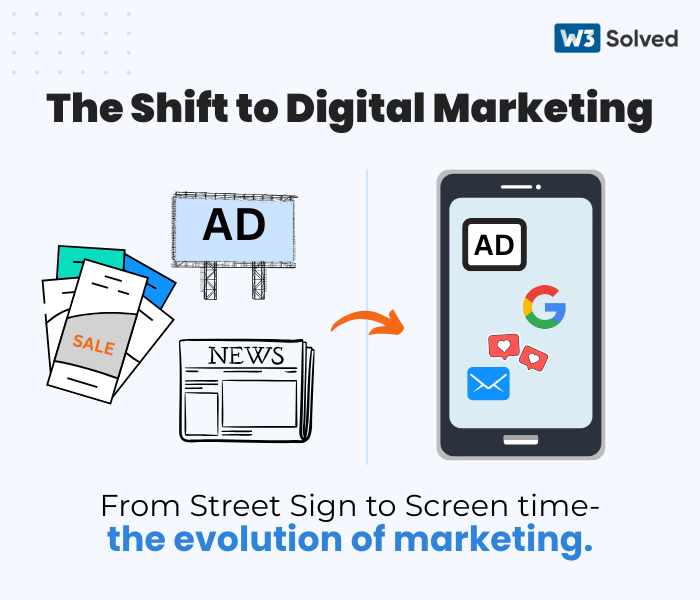The way people discover, interact with, and trust businesses has changed. Today, decisions are made online — long before a customer ever reaches out.
To stay relevant and competitive, brands must connect with their audience at every critical digital touchpoint.
What is Digital Marketing?
Digital marketing, also known as online marketing, is the promotion of brands to connect with potential customers using the internet and other forms of digital communication.
Marketing comes a long way from Billboards to newsfeeds. Your customers aren’t flipping through newspapers anymore — they’re scrolling, searching, and streaming. As behavior shifts, so must your strategy.

So the question comes to why digital marketing?
Well, digital marketing has become essential because people are spending more time online than ever before. Whether it’s browsing social media, searching on Google, reading emails, or watching videos, your audience is already online — and that’s exactly where your brand needs to be.
Digital marketing brings real business benefits, including:
- More Leads,
- Wider Reach,
- Targeted Marketing,
- Measurable Results,
- Better Customer Engagement.
This includes not only email, social media, and web-based advertising, but also text and multimedia messages as a marketing channel.
How Does Digital Marketing Work?
Digital marketing operates by connecting businesses with their target audiences through various digital channels, creating a cohesive and engaging experience that guides potential customers through their unique buying journeys.
This process encompasses four key stages:
- 1. Discovery
- 2. Engagement
- 3. Conversion
- 4. Retention

1. Discovery:
Goal: Bring potential customers to your website
Introduce your brand to potential customers by creating valuable and relevant content that resonates with their needs and interests. This includes strategies like,
- Search Engine Optimization (SEO)
- Paid Ads (Google, Meta)
- Google Business Profile Clicks
- Engaging social media posts,
- Valuable Content Marketing
2. Engagement:
Goal: Keep visitors interested and interacting
After capturing attention, companies foster meaningful interactions to build relationships and trust. This involves providing insightful and relevant content that addresses the audience’s needs and interests, encouraging them to interact with the brand.
- Clear Navigation & Visual Hierarchy
- Interactive Pricing Calculator
- Scroll Animations & Hover Effects
- Live Chat or Chatbot
- Mobile-Optimized & Fast Loading
- Portfolio, Testimonials, FAQs
3. Conversion:
Goal: Turn engaged visitors into leads or clients
With an engaged audience, the focus shifts to guiding prospects toward making a purchase or taking a desired action. This is achieved through clear calls-to-action, and personalized offers, effectively turning interest into action. This involves,
- Strong, Visible CTAs
- Contact Forms & Quote Requests
- Booking Widgets (Calendly, etc.)
- User-friendly website design,
- Case Studies & Landing Pages
- Sticky “Get a Quote” Button
4. Retention:
Goal: Keep clients coming back & referring you
The final stage is to maintain customer loyalty through ongoing engagement and value delivery. This can be achieved by providing exceptional customer service, feedback, and offering post-purchase support, ensuring customers remain satisfied and continue to choose your brand.
- Thank You Pages with Upsell Suggestions
- Email Sign-Ups with Incentives
- Client Portal or Support Access
- Re-engagement Email Campaigns
- Request for Reviews or Referrals
At its core, digital marketing is about understanding where your audience spends their time online and delivering relevant content that meets them at each stage of their decision-making process. This involves a blend of strategies tailored to attract, engage, and convert prospects into loyal customers.
Types of Digital Marketing
Digital marketing comes in many forms, each serving a unique purpose in helping businesses grow online. Depending on your goals , whether it’s getting more website traffic, building brand awareness, or increasing sales — you can use different types of digital marketing strategies to reach the right audience.
Here are some of the most common ones:
1. Organic Marketing:
Implementing effective SEO is a comprehensive process that often requires the expertise of professionals or specialized agencies. Key aspects of SEO include:
- SEO Audit to evaluate the current position of your website.
- Keyword Research to identify relevant search terms that potential customers use to find products or services like yours
- On-Page Optimization for improving website performance
- Quality Content Creation for developing informative and engaging content that appeals to your target audience and satisfies search engine algorithms
- Mobile Optimization to ensure your website is user-friendly on mobile devices, as mobile-friendliness is a critical factor in search rankings
- Backlink Acquisition for building a network of reputable backlinks to enhance your site's authority and credibility
Among various digital marketing techniques, SEO is frequently recommended due to its potential to drive long-term revenue without the ongoing costs associated with strategies like social media advertising. If you need assistance with implementing and managing your SEO strategy, consider exploring custom SEO services offered by professionals in the field.
2. Paid Marketing
Pay-Per-Click (PPC) Advertising involves creating targeted ad campaigns on platforms like Google Ads or Bing Ads to connect with potential customers actively searching for your products or services. You need to focus on choosing relevant keywords which will ensure that your ads appear in the right search results.
It’s not about targeting the right people; it’s about knowing which people you don’t want to target, as you don’t want to spend money on ads that won’t bring any results.
- Exclude irrelevant search terms
- Filter out low-performing locations
- Avoid devices or times with poor results
Once your ads are shown to the right audience, what you say matters. Your ad copy should quickly explain the value, give a reason to click, and set up a smooth transition to your landing page. That page needs to be just as focused—visually clear, persuasive, and built around a single action.
Managing your budget is not a one-time setup. As data comes in, shift your spending toward what works and pull back from what doesn’t.
A campaign that runs without review will always underperform. Ongoing testing and refinement are how good campaigns become great.
3. Email marketing
Email Marketing focuses on audience segmentation, dividing your email list into groups based on,
- demographics,
- purchase history, or
- engagement levels.
This segmentation ensures you can tailor your messaging effectively to each group. Customized emails address the unique needs of each segment, while automated campaigns, such as welcome sequences or cart abandonment reminders, engage subscribers at the right moments.
There are various types of emails you can send to both leads and current customers. These include,
- newsletters,
- email drip campaigns,
- abandoned cart emails, and
- lead nurturing emails.
You can further optimize performance by using tactics like A/B testing to identify which subject lines and content types resonate most with your subscribers.
4. Social media marketing
Social Media Marketing starts with identifying the social media platforms your target audience uses most, such as,
- Facebook,
- Instagram,
- Twitter,
- Tiktok, and
- LinkedIn.
Social media marketing focuses on organic strategies like posting, community engagement, and content creation. A well-planned content calendar ensures a balance of promotional, educational, and entertaining posts, keeping your audience consistently engaged.
Community engagement is crucial, requiring active interaction with followers through comments, messages, and mentions to build relationships and loyalty.
5. Social media Advertising
Social Media Advertising refers to paid campaigns on social media platforms. It includes creating ads, setting budgets, and monitoring performance to drive traffic, leads, or sales.
This form of advertising enables businesses to target based on,
- ages,
- jobs,
- interests, or
- behaviors etc.
You can A/B test with different ad creatives, headlines, and calls-to-action to identify the most effective combinations for your audience.
Also, proper budget management is key to ensuring your campaigns are cost-effective, while performance monitoring allows for ongoing optimization to achieve desired outcomes.
6. Website design and development
You can implement proper SEO and PPC marketing, but if you have a poorly designed website, your efforts won’t yield the desired results. It’s essential to craft your website to make it easy for visitors to navigate and take action. If your website has a confusing layout and is not responsive, it will deter potential customers.
Website design and development prioritizes creating a responsive design that ensures accessibility across desktops, tablets, and smartphones.
An intuitive UX is crucial for seamless navigation. By optimizing images and scripts, you can enhance page load speed and overall performance. Additionally, incorporating on-page SEO best practices will boost your website’s visibility in search engine results.
7. Conversion Rate Optimization
Conversion Rate Optimization (CRO) involves analyzing user behavior using tools like heatmaps and session recordings to understand how visitors interact with your website.
You can identify changes that drive conversions by conducting A/B testing on:
- web pages,
- headlines,
- images, and
- calls-to-action.
CRO will help you to understand your audience better. Tracking conversion metrics helps assess the impact of these changes and guides future improvements.
8. Content Marketing
Content Marketing begins with strategic planning to determine the types of content to create, such as
- blog posts,
- articles,
- videos,
- infographics, or
- podcasts.
Your website needs to post regularly to stay connected with your audience. Your content should use keywords strategically to enhance relevance and improve search engine rankings. Creating high-quality, valuable content will engage your audience and build trust. Regularly analyzing content performance helps refine your strategy and boost engagement.
Digital Marketing for B2B and B2C
Digital marketing plays a crucial role in helping businesses connect with their target audiences, whether they are B2B (business-to-business) or B2C (business-to-consumer). While both share common goals like increasing visibility, driving traffic, and generating leads, their strategies differ based on audience behavior and buying journeys.
B2B(business-to-business)
For B2B marketing, the focus is on building long-term relationships with decision-makers. Strategies often emphasize educational content, such as whitepapers, case studies, and webinars, which address specific pain points and position your business as a trusted industry expert.
To effectively reach professionals and executives, the best platforms include:
- LinkedIn,
- X (formerly known as Twitter),
- Certain Facebook groups
These platforms provide opportunities to engage directly with key decision-makers. Again, lead nurturing through email marketing and account-based strategies plays a significant role in converting leads into clients.
B2C(business-to-consumer)
In B2C marketing, the emphasis is on emotional appeal, driving quicker decision-making through engaging content and persuasive messaging.
To effectively reach consumers, the best social media platforms include:
- Instagram,
- Facebook,
- TikTok.
These platforms are ideal for showcasing visually appealing ads, partnering with influencers, and running seasonal promotions to engage and convert audiences. Since the buying journey in B2C is usually shorter, tactics like retargeting ads and limited-time offers are particularly effective at driving immediate action.
What Does a Digital Marketing Agency Do?
A digital marketing agency helps businesses grow their online presence by offering a range of services tailored to different goals.
Their role is to develop strategies that attract, engage, and convert your target audience across various digital channels.
Depending on your needs, a digital marketing agency might handle tasks such as search engine optimization (SEO), pay-per-click (PPC) advertising, social media management, email marketing, website design, and content creation. They combine creative skills with technical expertise to ensure every campaign is strategically planned and executed to deliver measurable results.
Rather than focusing on one-off tactics, a good agency takes a comprehensive approach — analyzing your current digital footprint, understanding your customer journey, and implementing solutions that work together to drive leads, sales, and long-term brand growth.
If you’re managing marketing efforts yourself, it’s important to keep your attention on growing your business and staying ahead with the best strategies. But if juggling everything feels overwhelming, you don’t have to do it alone.
With over 8 years of experience and a 99% client satisfaction rate, we have the expertise and tools to help your business rank higher and perform better online.
Let’s make 2025 a year of real growth — contact us today or give us a call at +1 (505) 623-9699.





